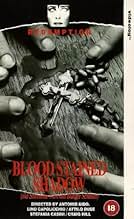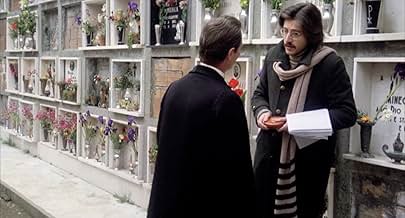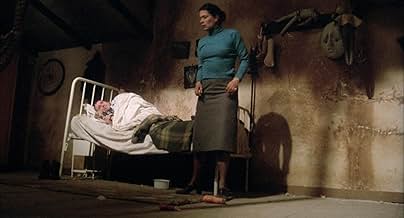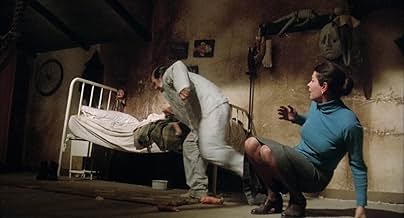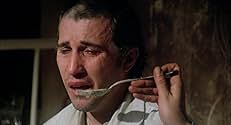VALUTAZIONE IMDb
6,3/10
2165
LA TUA VALUTAZIONE
Il corpo di una scolaretta viene ritrovato in un prato. L'assassino non viene mai catturato.Il corpo di una scolaretta viene ritrovato in un prato. L'assassino non viene mai catturato.Il corpo di una scolaretta viene ritrovato in un prato. L'assassino non viene mai catturato.
- Regia
- Sceneggiatura
- Star
Craig Hill
- Don Paolo
- (as Graig Hill)
Alina De Simone
- Medium
- (as Alina Simoni)
Sonia Viviani
- Girl walking with Signora Nardi
- (as Sonia Vivani)
Fortunato Arena
- Antonio, Innkeeper
- (non citato nei titoli originali)
Antonio Bido
- Man at cemetary
- (non citato nei titoli originali)
Eolo Capritti
- Customer in restaurant
- (non citato nei titoli originali)
Recensioni in evidenza
"The Bloodstained Shadow" is a film that requires patience. Had I not seen several giallos already, I might have fallen asleep in parts of this one. That being said, for giallo fans, this one is a worthy addition to your collection.
It starts out with a professor going back to his hometown, a small Italian island, and reuniting with his brother, a priest. The two become entangled in a web of murder and deception and it is somehow linked to the murder of a young girl year earlier. The setting is remarkable, the music is great and the acting is over par.
Then, we have the 'required' giallo elements. A love story. A suspect. Two suspects. Red herrings. Vague clues. Flashbacks. It gets a little ridiculous. By the time we find out who the killer is, (the first person I guessed,) we're a little worn out. There is a cheap shot which I cannot reveal because I'd give away the movie, but lets just say it's not fair to the viewer.
All being said, a really good ambiance and awesome setting give this film some merit. I'd recommend it to a hardcore giallo fan.
PS: now we know where the Blue Underground theme song comes from.
6 out of 10, kids.
It starts out with a professor going back to his hometown, a small Italian island, and reuniting with his brother, a priest. The two become entangled in a web of murder and deception and it is somehow linked to the murder of a young girl year earlier. The setting is remarkable, the music is great and the acting is over par.
Then, we have the 'required' giallo elements. A love story. A suspect. Two suspects. Red herrings. Vague clues. Flashbacks. It gets a little ridiculous. By the time we find out who the killer is, (the first person I guessed,) we're a little worn out. There is a cheap shot which I cannot reveal because I'd give away the movie, but lets just say it's not fair to the viewer.
All being said, a really good ambiance and awesome setting give this film some merit. I'd recommend it to a hardcore giallo fan.
PS: now we know where the Blue Underground theme song comes from.
6 out of 10, kids.
Watch Me While I Kill wasn't the best giallo in the world, so it's nice to Antonio Bido step things up a bit in this one, even though it's nearly two hours long.
In a place that isn't quite Venice but nearby, young Stefano returns home to stay with his brother, a local priest. Stefano suffers from flashbackitis, a disease where he keeps seeing a small crying child, but it's not all doom and gloom because it looks like local lass Stefania Casini is into him.
His priest brother is also a bit of a gossip, and fills Stefano in on the local freaks, including a phoney medium who may or may not be blackmailing her customers, which includes a backstreet abortionist with a dark secret, a doctor, and some rich gay guy who could also be a nonce. Then there's Andrea, the bereaved father of a girl we saw murdered at the start of a film, and Stefania Casini's crippled stepmother, who paints pictures, one of which sets off Stefano's flashbacks! Its like Eastenders, really.
After someone rather stupidly murders the medium in front of the priest's house, the priest starts receiving death threats, Stefano embarks on an investigation (while also putting the moves on Stefania Casini), and someone pulls on those old black gloves to do some murdering...
While overlong and very Argento-like, this is still a solid giallo with loads of twists and turns, and plenty of atmosphere too, due to the almost-Venice setting (I probably should have looked up where this takes place). There was enough going on to keep me entertained, and although I did eventually figure out who the killer was, I was still pretty satisfied by the proceeding.
You could also make a game out of what scene you've previously witness in a preceeding Giallo film: the Cemetary scene from Cat O Nine Tails, the crazy son hidden by his mother in Case of The Bloody Iris, the clue in the painting from Bird With The Crystal Plumage. Some people hate this one by the way.
In a place that isn't quite Venice but nearby, young Stefano returns home to stay with his brother, a local priest. Stefano suffers from flashbackitis, a disease where he keeps seeing a small crying child, but it's not all doom and gloom because it looks like local lass Stefania Casini is into him.
His priest brother is also a bit of a gossip, and fills Stefano in on the local freaks, including a phoney medium who may or may not be blackmailing her customers, which includes a backstreet abortionist with a dark secret, a doctor, and some rich gay guy who could also be a nonce. Then there's Andrea, the bereaved father of a girl we saw murdered at the start of a film, and Stefania Casini's crippled stepmother, who paints pictures, one of which sets off Stefano's flashbacks! Its like Eastenders, really.
After someone rather stupidly murders the medium in front of the priest's house, the priest starts receiving death threats, Stefano embarks on an investigation (while also putting the moves on Stefania Casini), and someone pulls on those old black gloves to do some murdering...
While overlong and very Argento-like, this is still a solid giallo with loads of twists and turns, and plenty of atmosphere too, due to the almost-Venice setting (I probably should have looked up where this takes place). There was enough going on to keep me entertained, and although I did eventually figure out who the killer was, I was still pretty satisfied by the proceeding.
You could also make a game out of what scene you've previously witness in a preceeding Giallo film: the Cemetary scene from Cat O Nine Tails, the crazy son hidden by his mother in Case of The Bloody Iris, the clue in the painting from Bird With The Crystal Plumage. Some people hate this one by the way.
Nothing more than an honest italian giallo, this movie tells the torbid story of a string of murders in a small town in the Venice laguna. A young mathematician will find the answer to one of his early nightmares, but he will not like the taste of it. A good music and a good atmosphere don't totally hide a lacking script (a few of the acts of the murderer are without a real, logical explanation), but this is the norm in several of more routinely italian gialli.
Directed by Antonio Bido, this is by far his best film of his career (Though, admittedly, his only other film of any note is the 1977 Giallo "Watch Me When I Kill").
The film's narrative is relatively typical of a giallo: Someone is killing people in a small village and a priest tries to unravel the mystery of the killer's identity. What's atypical is the film's tone. The film is noteworthy for being one of the more serious and mature of the giallo genre. Bido avoids the giallo's often sleazy nature and embraces the Gothic and religious aspects instead.
Another interesting point is how the film focuses on two main protagonists, the priest and his brother, and how they collaborate with one another to discover the killer. Interesting narrative method having two focal points rather than one, not original but unconventional.
The performances are generally good with Craig Hill as giving an impressive performance as the priest. He exhibits a broad range of emotions from anger to sorrow, from determination to helplessness, and makes it totally convincing.
The cinematography is main feature of the film because it is its strongest trait. The visuals portray a wet and muggy Italy, with fog and mist enveloping the landscapes and rain falling, creating pools of water. This all builds a gloomy and foreboding atmosphere that conveys feelings of isolation, loneliness, dread, anguish, and death.
The characters are generally good as well, each with a strong history and believable relationships between one another. The greatest of which is the relationship between the priest and his brother, which is totally believable because not only of both of their performances, but also the development of their characters.
And lastly, the film features some wonderful aesthetic qualities through it's use of editing. Bido inter splices Catholic and Religious imagery to make comments about the characters and the religious institution as a whole.
The film has a few problematic issues. First of all, the narrative isn't clearly focused. The film appears to be more concerned with the visuals and the individual, isolated events in the film rather than the mystery as a whole. Thus, this damages the film's impact as it approaches the end, because here the mystery plays center stage but is underdeveloped.
The narrative also suffers from several of the genre's conventions and clichés, thus leading to a sort of predictability of the story. The film features the typical gloved killer, the extended stalking sequences leading to a gruesome death, the multiple red herrings, childhood traumas, and a host of other archetypes of the giallo.
Also, the final revelation stretches plausibility and thus may become unacceptable to some viewers, especially when one recalls the events that have transpired throughout the film.
Never the less, this is one of the better giallos out there.
Recommended to those who enjoy the mystery/thriller genre, though it is not essential unless you are a fan of the giallo genre. For the casual film viewer, there are better examples of the giallo genre and thus would recommend that you skip this and view one of the apexes of the genre such as Suspiria.
The film's narrative is relatively typical of a giallo: Someone is killing people in a small village and a priest tries to unravel the mystery of the killer's identity. What's atypical is the film's tone. The film is noteworthy for being one of the more serious and mature of the giallo genre. Bido avoids the giallo's often sleazy nature and embraces the Gothic and religious aspects instead.
Another interesting point is how the film focuses on two main protagonists, the priest and his brother, and how they collaborate with one another to discover the killer. Interesting narrative method having two focal points rather than one, not original but unconventional.
The performances are generally good with Craig Hill as giving an impressive performance as the priest. He exhibits a broad range of emotions from anger to sorrow, from determination to helplessness, and makes it totally convincing.
The cinematography is main feature of the film because it is its strongest trait. The visuals portray a wet and muggy Italy, with fog and mist enveloping the landscapes and rain falling, creating pools of water. This all builds a gloomy and foreboding atmosphere that conveys feelings of isolation, loneliness, dread, anguish, and death.
The characters are generally good as well, each with a strong history and believable relationships between one another. The greatest of which is the relationship between the priest and his brother, which is totally believable because not only of both of their performances, but also the development of their characters.
And lastly, the film features some wonderful aesthetic qualities through it's use of editing. Bido inter splices Catholic and Religious imagery to make comments about the characters and the religious institution as a whole.
The film has a few problematic issues. First of all, the narrative isn't clearly focused. The film appears to be more concerned with the visuals and the individual, isolated events in the film rather than the mystery as a whole. Thus, this damages the film's impact as it approaches the end, because here the mystery plays center stage but is underdeveloped.
The narrative also suffers from several of the genre's conventions and clichés, thus leading to a sort of predictability of the story. The film features the typical gloved killer, the extended stalking sequences leading to a gruesome death, the multiple red herrings, childhood traumas, and a host of other archetypes of the giallo.
Also, the final revelation stretches plausibility and thus may become unacceptable to some viewers, especially when one recalls the events that have transpired throughout the film.
Never the less, this is one of the better giallos out there.
Recommended to those who enjoy the mystery/thriller genre, though it is not essential unless you are a fan of the giallo genre. For the casual film viewer, there are better examples of the giallo genre and thus would recommend that you skip this and view one of the apexes of the genre such as Suspiria.
As fans of this particular genre, "giallo", knows there are some characteristics that have to be included: POV-shots from the killer, black gloves and grisly, graphic murders and so on! The gloves are missing here but everything else is! The story is set in Venice where bizarre events are unfolding, leading to death-threats and murders. And everything is connected to an episode many years ago, concerning the strangulation of a young girl. There are echoes from many other giallos, like the classic "Deep Red", but unlike so many other imitators, director Antonio Bido (who made the inferior giallo "The cat's victims") has a true feeling for setting up the set-pieces. His actors are also quite good even if the dubbing, as always, may distract from the viewers pleasure. His knows how to place his camera to enhance the suspense and atmosphere. To complain a little, I too found, like a previous reviewer here, that the episodes between Casini and Capolicchio are a bit squirm-inducing. They are simply put, very boring together, and even a nude scene fails to give any sparks. And the boat trip they take together is a scene that should have been omitted (I do HATE those sunglasses) because it seems to belong in another movie altogether, like some travelogue movie. But otherwise a nice exercise in suspense and horror, even if it is talky in places (most gialli are) and takes some time to get the pace going.
Lo sapevi?
- QuizAt 28'51' when Capolicchio introduces himself to Stefania Casini he tells her he is a Professor of Mathematics, Casini tells him that her job is to deal with furniture and Capolicchio calls her Architect, Stefania Casini actually graduated in Architecture at Polythechnic University of Milan.
- BlooperWhen the killer is being revealed and the main character pulls out the newspaper article, you can see and hear a flash from camera, probably taking pictures of the scene.
- ConnessioniFeatured in Solamente Bido (2002)
I più visti
Accedi per valutare e creare un elenco di titoli salvati per ottenere consigli personalizzati
- How long is The Bloodstained Shadow?Powered by Alexa
Dettagli
- Tempo di esecuzione1 ora 49 minuti
- Mix di suoni
- Proporzioni
- 1.85 : 1
Contribuisci a questa pagina
Suggerisci una modifica o aggiungi i contenuti mancanti

Divario superiore
By what name was Solamente nero (1978) officially released in India in English?
Rispondi
